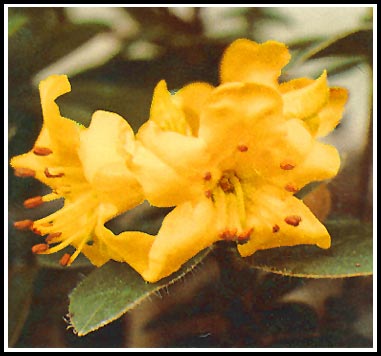QBARS - v34n4 R. chrysodoron
R. chrysodoron
Harold Greer, Eugene, Oregon

|
|
R. chrysodoron
Photo by Harold Greer |
When Lord Stair found gold in his garden, he decided the only place for such precious gold would be to make a gift of it to the Royal Botanic Garden. What was this golden gift he gave? It was the plant now known as R. chrysodoron . Since the plant did not have a name and Latinized names such as "stari" or "stairum" after Lord Stair sounded very sterile and uninviting, someone came up with the name 'chrysodoron' which means golden gift, referring to the fact he gave this golden yellow flowering plant to the Royal Botanic Gardens.
Actually, it is a pure golden yellow of such beauty that few flowers compare with it. And only in the Malaysian rhododendrons do you find a yellow to match it.
It is a member of the Boothii series and has elliptic to oblong elliptic leaves which are densely scaly below. They are two to three inches long and are covered on the margins with bristly hair. The new growth has a bronze appearance and the bristly stems are bright red. The flowers appear in trusses of three to six, are up to an inch and a half long and are widely bell-shaped. They are bright golden canary yellow with no spotting.
Though the English books say the plant flowers in April, my experience has been that it tends to flower in the fall, winter or early spring, often over a long period of time. It's time of flowering is also more like the Malaysian rhododendrons, unusual for a plant that is native to Yunnan at 6,500 to 8,500 ft.
It propagates quite well, though parent plants seem to resent being cut heavily for several years. It is too bad that it is not more hardy and with the exception of the nearly frost free areas, it is a container plant for a greenhouse.
One form was awarded an Award of Merit in 1934 when it was shown by Lord Aberconway at Bodnant. It is also the parent of the very fine 'Chrysomanicum' which is a hybrid of R. chrysodoron and R. burmanicum .
